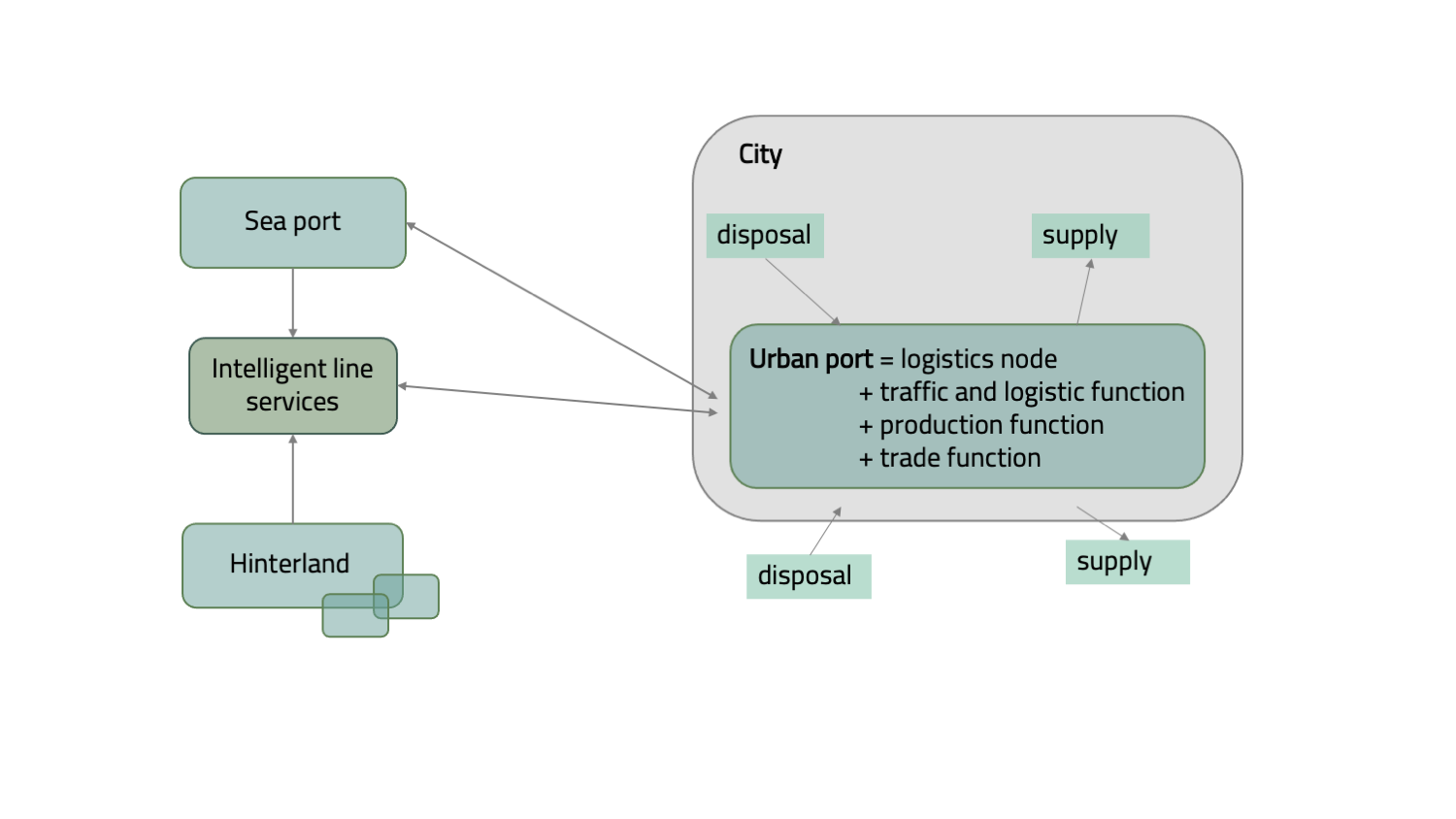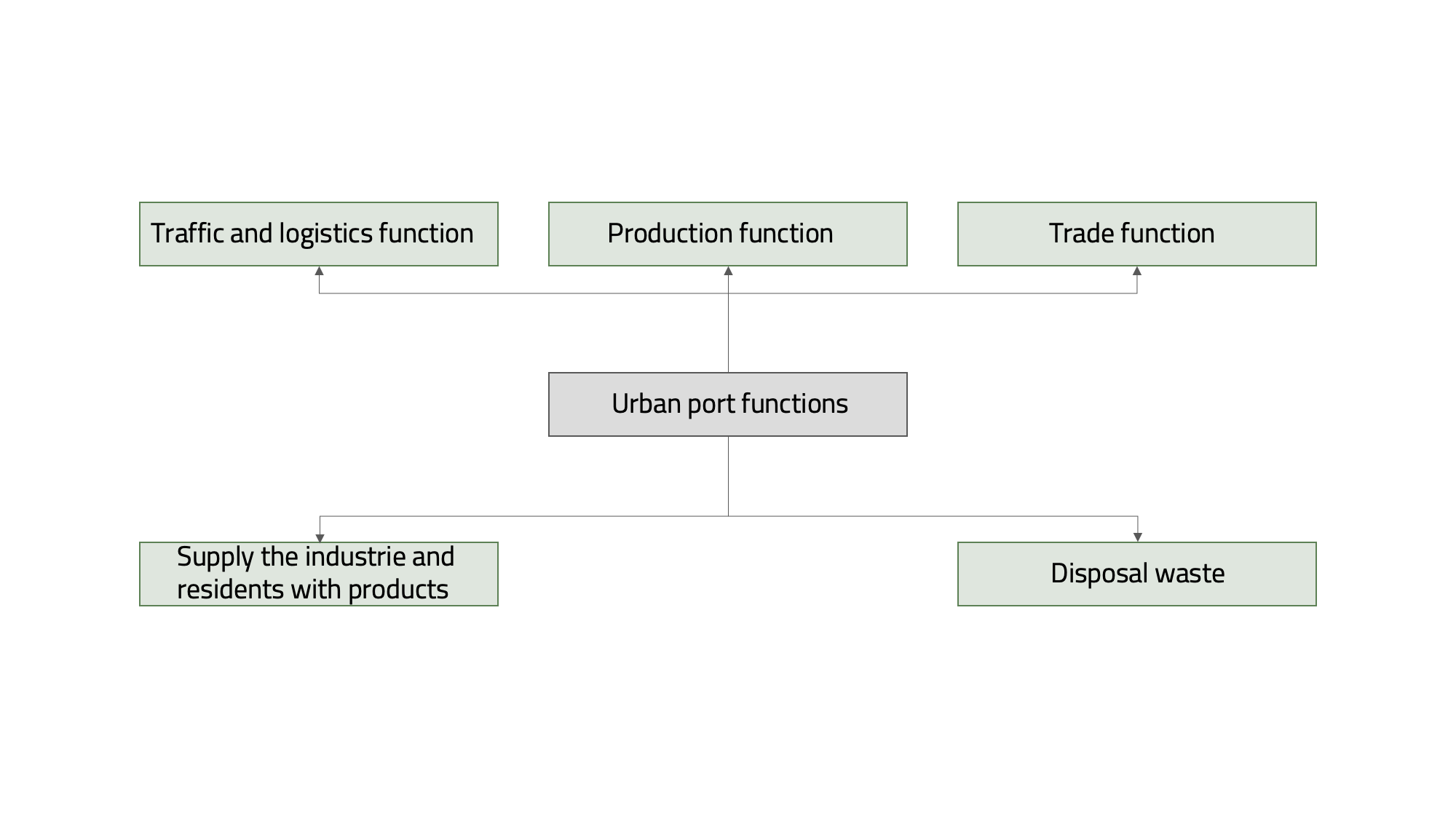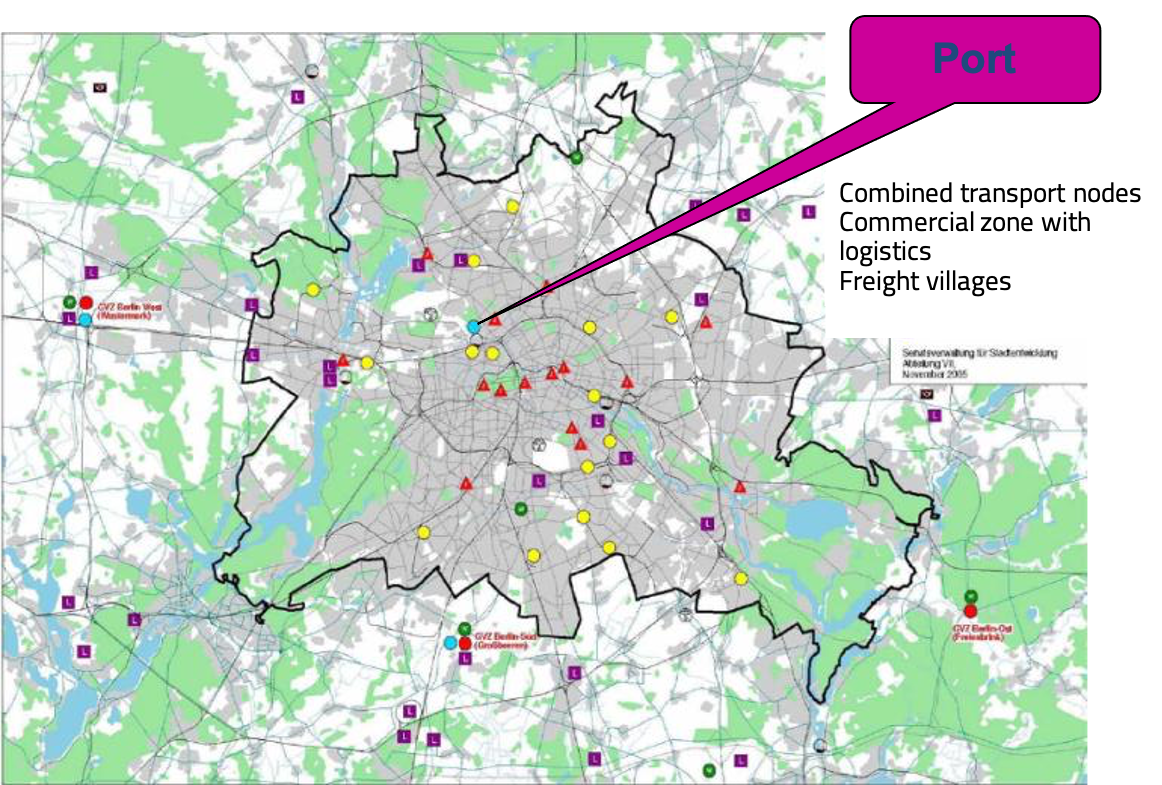Inland Waterway Transport System
6. Ports
In the inland waterway transport system, the facilities are called "Ports". Ports are the prerequisite to transport the goods on the inland waterway system.

It's probably best to start directly with an example, so that you can visualize it better. As an example we take the west port of Berlin.
Inland ports
Inland ports
The Inland ports are located more centered in the inland of the countries and are responsible for transshipment between the modes of transport rail, road and inland waterway. Inland ports can also be located downstream on the territory of a seaport to transport the loading units from and to the seaports.
Inland ports still play an important role in the supply and disposal of the region and are (mostly trimodal) interfaces of the transport modes. They are confronted with numerous competing uses. In Germany there are about 1,200 port and transshipment sites, of which about 100 inland ports are public.
Inland ports still play an important role in the supply and disposal of the region and are (mostly trimodal) interfaces of the transport modes. They are confronted with numerous competing uses. In Germany there are about 1,200 port and transshipment sites, of which about 100 inland ports are public.
The figure "Inland port as transshipment points" shows the connection between the city, urban port, sea port and hinterland. The urban port as a logistics node also has a traffic and logistic, production and trade function and interacts with the city to supply the city, as well as to dispose things from the city. The sea port and the urban port are connected by water where the loadings are being transported between the two nodes. The sea port is connected to the hinterland (mostly trimodal) and is delivering loading units to and from the hinterland. The sea port, urban port and hinterland are ideally interconnected and use intelligent line services to optimize all transport processes between the nodes.
Urban port functions
An urban port has a lot of important and different functions. One function is the traffic and logistics function, so that the goods can be transported on the waterway, transferred from water to land and then send to the final destination. Some steps in the production of goods are executed directly at the port (production function). The same applies to the trade function, as a lot of trade is done directly at the port.
An urban port supplies the industries and residents with different types of goods but also disposes the waste of them.
City Terminals for Urban Logistics: Location of logistic ports in Germany
In addition to the inland ports Hamburg and Berlin, there are many other inland ports in Germany. A large number of them are located in the southwest of Germany. Many city terminals are located quite close to each other, forming different clusters.
In addition to the inland ports Hamburg and Berlin, there are many other inland ports in Germany. A large number of them are located in the southwest of Germany. Many city terminals are located quite close to each other, forming different clusters.
City Terminals for Urban Logistics: Location of Inland Ports (for example Berlin Westhafen – west port of Berlin)
The Westhafen port of Berlin is one best practice example of an urban port.
The Westhafen port of Berlin is one best practice example of an urban port.
It is located near the city center with about 1 million inhabitants and about 700.000 workplaces.
This urban port is part of the city terminal concept for urban logistics of Berlin to supply the city and implement environmentally friendly transport chains.
As a trimodal port, it offers the handling of all kinds of goods and of heavy goods up to 500 tons and stocking in yards, buildings and silos. The total throughput of containers in the year 2018 was more than 43.000 TEU.
Every day, container block trains from North Rhine-Westphalia and, in port hinterland traffic, from Hamburg and Bremerhaven are dispatched.
The figure "Inland port Berlin Westhafen" shows important logistic nodes like the combined transport nodes (blue circles) and commercial zones with logistics freight villages (pink rectangle and red circle) in Berlin. The port is located in the middle of the important logistic nodes.
It is also interesting to know what the surroundings/land use of the port look/s like.
It is also interesting to know what the surroundings/land use of the port look/s like.
Land use around the Westhafen port in Berlin
The image "Land use around the west port of Berlin" shows the different land uses in the port. The port is located directly on the waterfront and is surrounded by an industrial area on one side and residential areas on the other. This illustrates the difficulties of an urban port that must accommodate the needs of both industry and residents living near the port.
The image "Land use around the west port of Berlin" shows the different land uses in the port. The port is located directly on the waterfront and is surrounded by an industrial area on one side and residential areas on the other. This illustrates the difficulties of an urban port that must accommodate the needs of both industry and residents living near the port.

Urban ports: SWOT-analysis
SWOT analyses are tools used for strategic planning. The goal of the detailed documentation is to analyze the strengths and weaknesses and opportunities and threats. Here we apply this to urban ports and look at their current position.
SWOT analyses are tools used for strategic planning. The goal of the detailed documentation is to analyze the strengths and weaknesses and opportunities and threats. Here we apply this to urban ports and look at their current position.
S - Strengths:
- tri-modal accessibility
- superstructure / equipment for tri-modal handling
- comprehensive range of services for handling, transportation and storage of break bulk, bulk, liquid and heavy cargo
- operator model provides one-stop services
- regional or local geographical integration
O - Opportunities:
- integration of transport chain to relieve the seaports and land-based transport systems
- network integration (e.g. of terminal operators to bypass bottlenecks at the major gateways)
- enhanced awareness of inland ports by targeted public relations
W - Weaknesses:
- limited expandability due to missing land reserves (e.g. conservation area)
- lack of political support for the ports in the city and missing legal requirements (e.g. monument protection, immission)
- potential for conflict caused by emissions
- limited reliability of the water-side accessibility by low tide, locks, or something similar
T - Threats:
- increased competition from road and rail in the same market segments (e.g. bulk cargo)
- structural adjustment and growth restrictions in the city ports by problems of acceptance and pressure of implementation („urban waterfront“)
- area bottlenecks
The relation between the elements goods and ports is called accession.
Accession
In the past, towns sprang up around ports, as they were the focal point of trade. Often they were also the closest transport node near the extraction of raw materials or production.
Literature
Abgeordnetenhaus zu Berlin (2006): Stadtverträglicher Wirtschafts- und Güterverkehr in Berlin. Drs 15/4720
Flämig, H., Schulte, N. (2011a): Binnen_Land: Die Situation der Binnenhäfen und mögliche Handlungsstränge. Teil I des Abschlussberichtes zum Forschungsvorhaben. Band 6. Harburger Berichte zur Verkehrsplanung und Logistik.
Flämig, H., Schulte, N. (2011b): Binnen_Land: Kommunikation in der Binnenschifffahrt. Teil III des Abschlussberichtes zum Forschungsvorhaben. Band 8. Harburger Berichte zur Verkehrsplanung und Logistik.
Flämig, H., Schulte, N. (2011a): Binnen_Land: Die Situation der Binnenhäfen und mögliche Handlungsstränge. Teil I des Abschlussberichtes zum Forschungsvorhaben. Band 6. Harburger Berichte zur Verkehrsplanung und Logistik.
Flämig, H., Schulte, N. (2011b): Binnen_Land: Kommunikation in der Binnenschifffahrt. Teil III des Abschlussberichtes zum Forschungsvorhaben. Band 8. Harburger Berichte zur Verkehrsplanung und Logistik.
Flämig, H., Sjöstedt, L., Hertel, C. (2002): Multimodal Transport: An Integrated Element for Last-Mile-Solutions? Proceedings, part 1; International Congress on Freight Transport Automation and Multimodality: Organisational and Technological Innovations. Delft, 23 & 24 May 2002. (modification of Sjöstedt 1996)
Meister, V.; Bayer, S. (2010): Lokale Akzeptanz von Binnenhäfen. Analyse der Bedingungen für ein konfliktfreies Miteinander von städtischen Binnenhäfen und Anwohnern. Berlin: FU Berlin / Institut für Geographische Wissenschaften (= METAR – Papers in Metropolitan Studies; Bd. 55)


